How to Write a "Thank You For Your Order" Note For Customers

Any time you're selling a product, you will want to acknowledge when a customer makes an order. A simple automated order confirmation email is acceptable, but why not take it one step further?
That's where the "Thank You For Your Order" note comes into play.
It's even more critical in a world increasingly beset by automated drop-shippers, social media ads, and cheap knock-off products. It's challenging to feel appreciated as a customer, and when an item you ordered shows up with a barely-English set of instructions, it doesn't inspire confidence.
Often, you can engage with a customer and retain their loyalty and customer satisfaction through a combination of a good product and a good experience. It's sad to say, but even a simple personalized touch is enough to make you stand out, and that's meaningful.
A personalized note also helps you stand out more in a customer's mind. To quote PackHelp:
"…when people buy from marketplaces like this, they don't remember your name.
They remember the name of the marketplace. "I got this on Etsy, which was discounted on Amazon."
There is no mention of the brand name or reference to the seller or eCommerce store name. Etsy takes all the credit.
This same problem happens when we talk about many modern services.
- "I watched Netflix last night," no mention of what movie they watched.
- "I had UberEats last night," no mention of which restaurant.
This phenomenon diminishes the effect of one of the most potent forms of marketing - "Word of mouth marketing."

When you build that personal connection with the customer, they're much more likely to mention you by name rather than the platform they bought through. This situation is, of course, more relevant when you're selling through Amazon, Etsy, or eBay, rather than when you have your own site, but the point stands either way. It's both thoughtful and effective for customer retention.
On the surface, it's not difficult to create a "thank you for your order" note for your customers. All you need to do is write "thank you for your order" on a piece of cardstock and include it in the package. Right?
Well, that can work, but you can do so much more with a little effort.
 30 Second Summary
30 Second Summary
You should add a personal note when customers buy from you because it helps you stand out in today's automated shopping world. You can send digital notes with email or include physical handwritten notes with orders - or do both. When you write your note, you need to use the customer's name and avoid promotional language. You should introduce yourself, express genuine thanks and maybe ask for a review. You can also include a small gift or freebie to make customers feel extra special, but don't just add discount codes as they feel too promotional.
Digital, Physical, or Both?
One of the first things you should decide is what form your thank you note will take.
1. A digital thank you note should be sent shortly after confirming the order. You can personalize it, and while you can use templates, it should be unique enough that a repeat customer doesn't necessarily get the same note each time. Such a note can also include value-adds, like a usage guide, a pro tips guide, an invite to a community of product owners, or something similar.
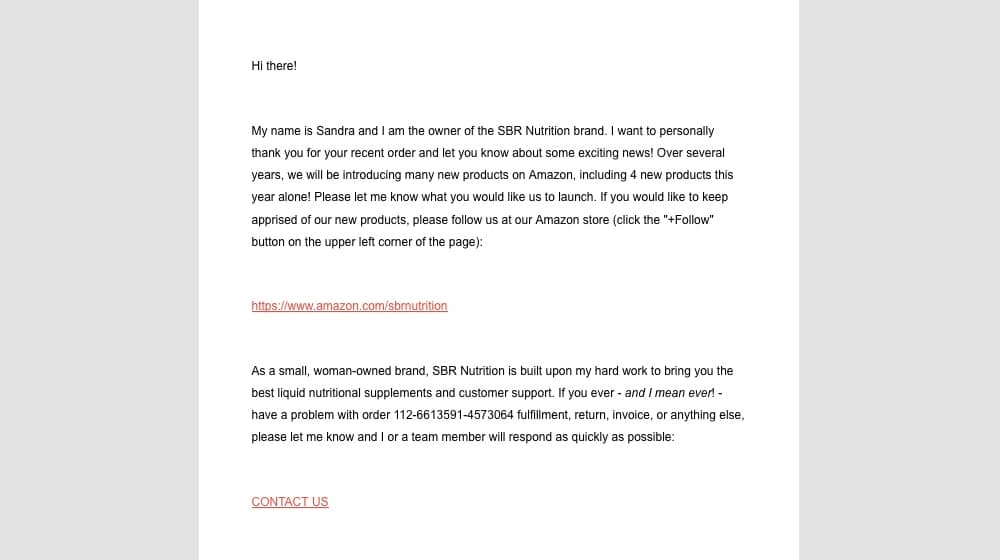
This message should be distinct from, and in addition to, the standard automated order email from the customer's purchase. This separate message increases the customer's likelihood of reading and enjoying it.
Of course, some people don't want more email clutter and might not appreciate email templates. Physical notes work better in many cases precisely because of this. You also don't risk hitting their email spam filter; they will see a physical message and it will be clear it was written by a real person.
2. A physical note should be included with the package and order the customer has shipped to them. It can be printed or handwritten, and can you can personalize it. I'll dig deeper into what should go into one as we go through this post.
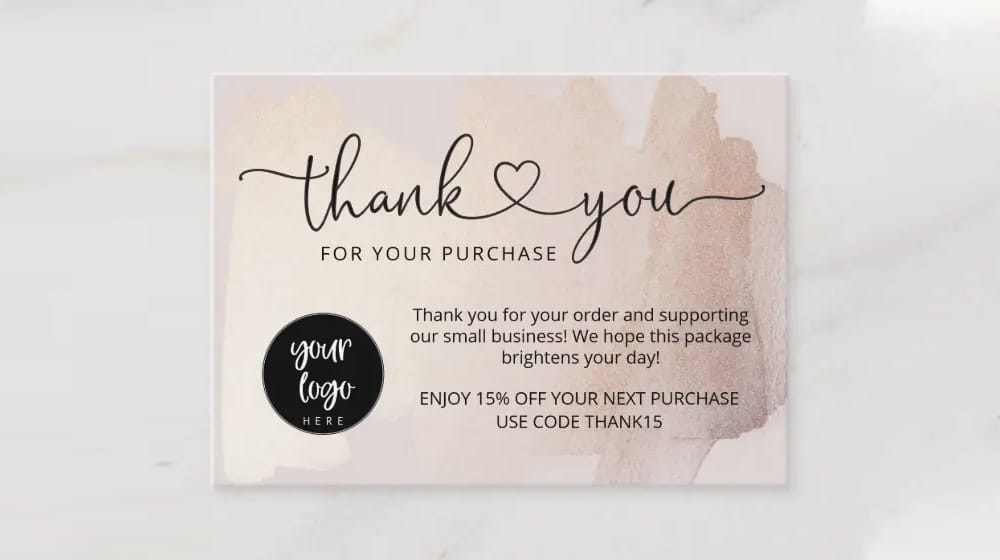
Physical notes are slightly more of a burden than an email. It can be time-consuming to print or write something and make sure it gets into the right package and is customized to the order. However, that personal touch can go a long way towards making a customer feel special, and the value that brings that shouldn't be overstated.
3. You can also use both, of course. Each method serves different purposes. An email can be a gateway to drip-feed marketing, increased engagement, and links to resources that make using your product more approachable. A one-time handwritten letter in a package can be meaningful and engaging but doesn't open up the door to future messages unless the customer makes another order. However, rewarding repeat customers with personalized messages can also be a great option.
For the bulk of this post, I will discuss a physical note. Some tips can apply to an email, but I want to focus this guide on physical thank you cards.
Printed or Handwritten?
Another choice you must make is whether your note will be printed or handwritten.
1. A handwritten note shows a lot more personalization and care. It is, to put it simply, special. Very, very few companies consider handwriting notes to their customers. After all, it's a significant burden; handwriting requires more supplies, time, effort, and accuracy than a printed note. You have to do everything from getting the customer's name spelling right to making sure your writing is legible and, of course, making sure the right note goes into the right package. An individual or small business on Etsy has a much easier time of this than a high-volume online store.

2. A printed note can still be effective, especially if you customize it, but it does lose some of the charms of a handwritten note. It's not as memorable, even if you typed out a custom note every time.
Sometimes you can split the difference and use a handwriting font (and sign your name each time), but that can be iffy. Some people don't like being "lied to" that way and may feel worse about it.
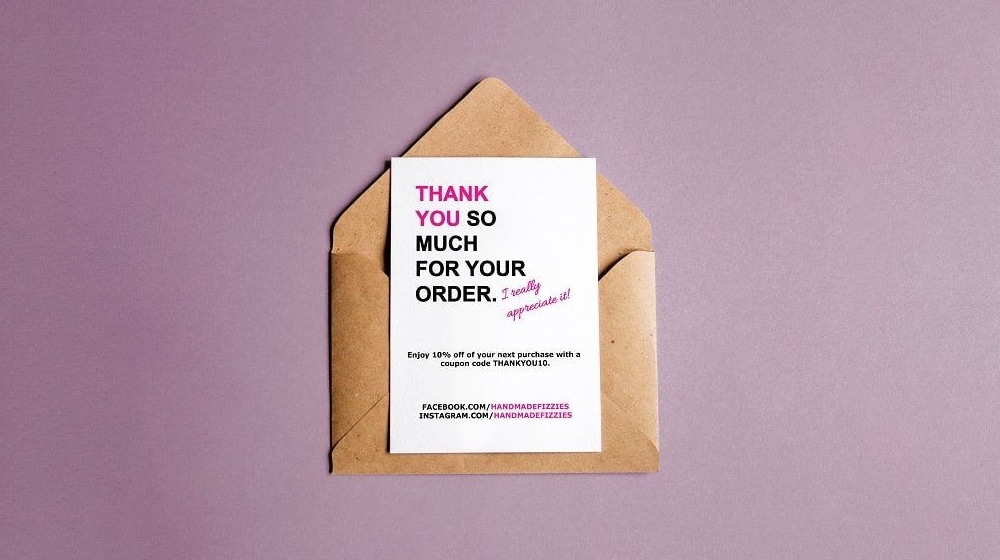
Some services, such as Scribeless and RoboQuill, will take the text you want to send a customer and write, seal, and mail a handwritten note on your behalf. Their pricing is high for lower volume (about $3 per message). Still, this solution might be ideal for a business with expensive products or a larger order volume to take advantage of discounted pricing.
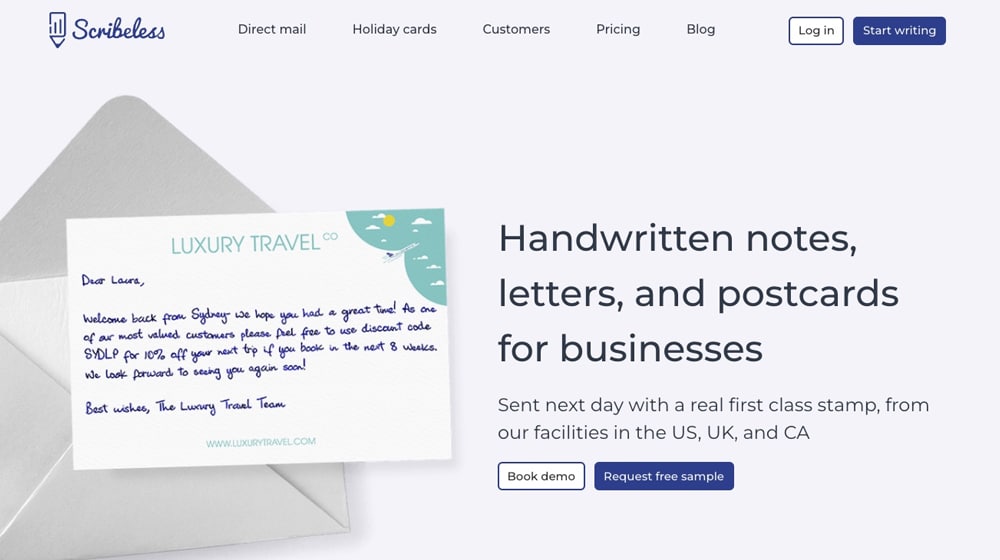
Of course, if you don't have the time, the manual dexterity, the budget, or the initiative to handwrite however many notes you need for every package, you should choose a printed option instead.
All Orders, or Just Some?
Another choice you'll want to make is whether you're sending a note with every order or just some of them.
One of my best customer experiences was when I ordered a reasonably nice piece of electronics from a company. They sent me a handwritten note thanking me for the purchase, which included some tips about the product.
More importantly, I later realized I wanted an accessory to go with it. I made my next purchase, and when the order arrived, it had a note that thanked me for the purchase but also had a little joke about forgetting it the first time around. It made me smile to see, and you know what - that good experience fostered more customer loyalty to that brand than you might expect, even in my cynical marketing mind.
You can also set up a system to recognize repeat customers and make your next order messages contextual.
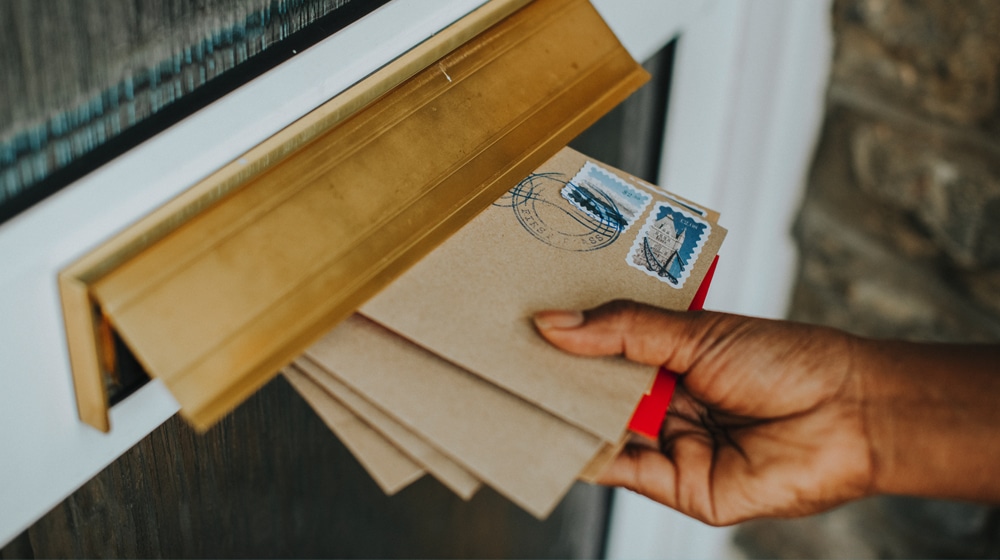
Of course, the level of complexity can vary. It's up to you to find the right balance that reflects how personalized and individual your brand is.
What Should The "Thank You" Note Contain?
A simple "thank you for your recent purchase" note is good, but what else should it include to make your message shine?
1. Personalization
Instead of just "dear customer" or "greetings" as a salutation, customize it with the name of the person ordering it. "Dear Jane" is better than "dear customer," after all.
You can also customize this further. A quirky brand might write something like "To our favorite new customer, Jane." You might recognize loyal customers and include something closer to "Welcome back, Jane!"
Pro tip: you can also consider offering unique customization for gift orders. Since you include the note in the package - if the customer is getting it as a gift for someone else, that someone else may not appreciate a note to the gift-giver. You can make it even more personalized by allowing the customer to specify a different recipient (or even a different message entirely).
2. Introduce Yourself
Depending on the size of your business, you can introduce yourself in this note. You might write, "My name is James, CEO of Content Powered, and I'm just pleased to have you join our family."
If your business is large enough that the average customer will find it implausible that the CEO is spending time writing these notes, you can instead be more generic. "On behalf of the Content Powered team, I'd like to welcome you to the family."
3. A Variation on The Theme
While it's called a "thank you for your order" note, one thing you probably don't want to do is use that phrase as-is. It's a bit too rote and not personalized enough. Instead, try something like:
- Thanks for supporting our small business!
- We're glad to have you as a valued customer!
- Welcome to the {Company Name} family!
These kinds of customer appreciation examples can go a long way towards building a connection between you and the brand.
4. Avoid More Promotions
As marketers and business owners, we're often tempted to shoehorn a call to action in everything we write.
There are a few ways you can include a bit more promotion without targeting the customer directly, though. For example:
- Include a couple of business cards the customer can hand out to friends who might like what they bought from you and want one of their own.
- Include a freebie like a coupon code for a subsequent order.
- Include a call to action to "don't hesitate to reach out if you have any questions."
These kinds of soft promotions can help build that connection, expand your exposure area, and provide additional value for your customers.
5. A Review Request
One clever thing you can do is request a review compellingly. You probably shouldn't just write something like,
"Once you've had a chance to use our product, I'd love it if you could leave us a review."
Instead, you can play on the emotional connection to a small business.
"As a family-owned company, we live or die on our reputation, so it would be great if you could leave a review when you get the chance."
Alternatively, you can personalize it in a request for customer feedback.
"This is one of my favorite products we sell, so I'd love to hear what you think about it."
6. A Closing
A simple sign-off is all you need.
"Thanks again! – James"
If your note is printed rather than handwritten, you might want to sign the closing of your messages. Even that additional personal touch can be better than nothing.
Consider a Small Gift
A freebie is another thing you might consider when you personalize your thank you message.

A freebie can be about anything, as long as it stands out.
- Some free branded stuff, like a keychain, bottle opener, or sticker.
- A small, branded tool, like a small screwdriver or a spudger, may be helpful. (You've never heard of a spudger? It's a small pry tool for servicing electronics).
- A bit of candy or another treat for the customer.
You can also ramp up the freebies for known repeat customers and include things like coupons, gift cards, or accessories they might find helpful.
A discount code isn't a freebie; it's a marketing technique. These can still be effective when paired with other freebies, but ask yourself; would you give somebody a coupon to a store for Christmas? It's a funny thought, but it's hard to consider it a gift.
Put It All Together
It's all pretty straightforward. Everything on the list above is no more than a sentence (and a few cents) to do, but when you put it all together, you have a great, personalized note and possibly even a gift to give your customers, which fosters loyalty like nothing else. What more could you ask for?



 30 Second Summary
30 Second Summary
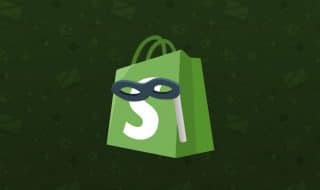


Comments